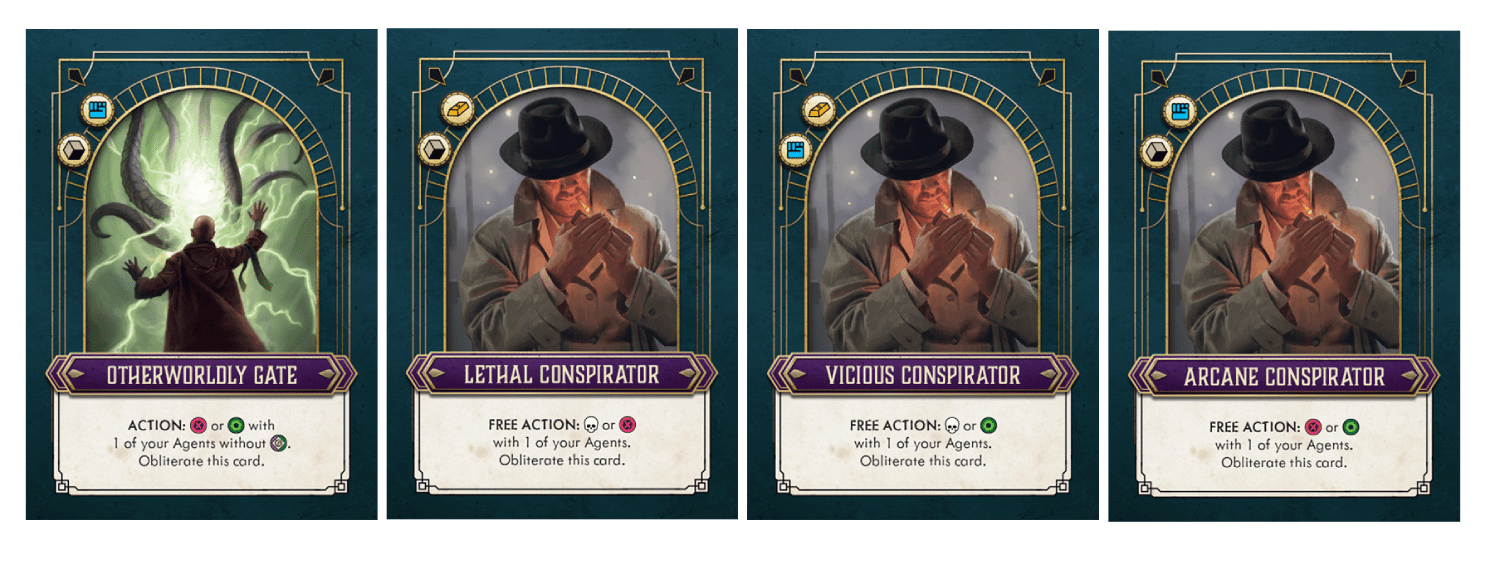
Cthulhu: Dark Providence Dev Diary #2: Embracing the Madness
Travis Chance, one of the lead designers on Cthulhu: Dark Providence, talks about the different iterations and editions of the game and how they contributed to his own design.
A Study in Emerald had two editions prior to the design of Dark Providence. The first edition was unique for several reasons, but one of the most notable differences to the second edition were audacious card designs in an already inspired game. There were cards with entire sets of components, that completely altered the game, and even had so much complexity that more thorough explanations could only be found in the rule book.
The second edition sought to make the game more approachable, as its core system was more than enough. But in doing so, many of the wilder cards were left on the cutting room floor. The more complex cards were removed, which made for a quicker, cleaner game, but also a different game in terms of those high impact moments.
ome might ask, why would I need another version of this game? Well, allow me to elaborate.
Dark Providence aims to hit that goldilocks zone between the two editions of Study while being its own game. As mentioned in the prior diary, the alignment system works great at all player counts—including solo! Rules have been streamlined. For example, cities and the gates on the map now each have a single metric players must match. We also wanted to elevate the players’ ability to maintain the secrecy while allowing for more scoring options within each of the possible alignments.
Investigators have six out of 22 agents with Investigator VP. Gate strength values now had an average strength of 3-4, making sealing more abundant. Four of the 12 cities allowed for Investigator track advancements exclusively, while only one city does so for Cultists.
Protecting gates (Hide Royalty) was tough to do in Study, but there are ample means in Dark Providence. Cultist VP can be found on Mythos cards, as well, but always at the risk of a sanity test. The Elder Ones all provide Cultist VP, but none more so than the titular Cthulhu. And let us not forget two of the craziest cards from 1st edition: Vampire and Zombies. While these were redesigned and renamed, they still function much the same, providing VP for those that conspire with dark forces.
Dissidents miss out on all the Investigator and Cultist VP, but luckily there’s general VP to be had as well. The Necronomicon remains unchanged, providing 3VP right away. The new card Lost City also gives immediate VP, providing the player that claims it with the 13th city card of R’lyeh which slowly drives players to insanity. Kana Mishima is the only agent with general VP, as well as a powerful agent card to boot. Then there is Randolph Carter, who allows for an entire scoring strategy for Mythos cards. The Silver Key allows players to blindly claim cards set aside during setup, while Danvers State Hospital can return an insanity token to the supply or cause a player to test sanity, possibly triggering the end of the game. Herbert West reanimates assassinated agents.

We increased the power level of cards across the entire game. City cards are no longer weak liabilities to counter their VP. Instead, they are lynchpins to entire strategies. For example, Detroit is the only card in the game with three wealth icons, making it a powerful tool for travel. We also made sure that cards were equally desirable for all alignments where possible. Elder Ones might score for Cultists, but all of them have powerful claim and ongoing effects that create entire strategies. Basic cards like Otherworldly Gate allow for sealing and protecting gates without a sanity test. The card Hired Assassin inspired the trio of Conspirator cards, each which allows two different options for assassinating, protecting, and sealing gates.

There is an arsenal of new Asset cards for players to explore. Corruption is a nod to the Double Agent mode of 1st edition, stealing a recruited agent from another player. Dimensional Anomaly obliterates every card in the same city, advancing the Cultist track and adding 2 more Mythos cards to the row. Secret Order allows influence in Limbo to be placed on a card and then advances the lowest track. And Saboteur, my very favorite new design, is given to another player to weaken their deck.

Every recruited agent in the game is entirely unique, many of which provide powerful abilities. Father Lachlan is decidedly valuable for Investigators with 1VP and the ability to seal gates, but he also has an action to retrieve ALL of your influence from Limbo. The Widow is an assassin that also has the unique ability to peek at a player’s alignment. And Harry Houdini is one of three agents whose agent token has a passive effect: he cannot be assassinated… at all.

The Mythos cards are doubled in Dark Providence from 12 to 24. And this is where many of the more insane cards can be found. Some of the designs from Study endure, but most are brand new. Even cards.
Like Carl Jung that took inspiration from Study are more versatile, allowing you to give the card to another player that might be looking to end the game by being driven to insanity. The new cards steer into the skid, creating high impact moments and lines of play that did not previously exist.
I shall see you all again in the next diary, where we will discuss the world of Dark Providence.
Player Support
Need Assistance? Click here to reach our dedicated Customer Support team for help with your order, address changes, refunds, or parts replacements.